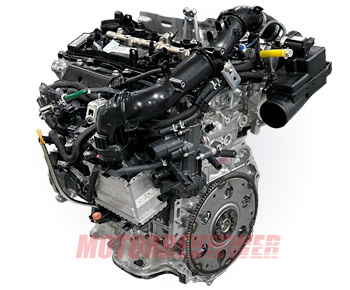Toyota T24A-FTS 2.4L Engine Specs, Problems, Reliability, Info

Toyota 2.4 D-4ST Turbo Engine Info
The T24A-FTS, also known as the 2.4 D-4ST, is the latest four-cylinder engine out of Dynamic Force family, which equipped with twin-scroll turbocharging and combined fuel injection system. This 2.4-liter engine was first introduced in 2021 as a new power option for the Lexus NX AZ20 series. With this engine, Toyota has begun to replace the 2GR-FKS naturally-aspirated V6 and the 8AR-FTS 2.0-liter turbocharged engine. Now, the T24A-FTS engine is available for a wide range of Toyota and Lexus vehicles, such as Toyota Highlander, Toyota Tacoma, Toyota Land Cruiser Prado, Toyota 4Runner, Crown Crossover, Lexus TX 350, Lexus RX 500h and more.
2.4 D-4ST T24A-FTS Engine Features
Like all engines in the Dynamic Force series, the T24A-FTS is built around an aluminum, open-deck type cylinder block with cast-in iron liners. The crankshaft is positioned with a 10-millimeter offset and drives the separate balancing mechanism through a train of polymer gears. The engine block features forged connecting rods, lightweight T-shaped pistons with a polymer coating on the skirts, and oil squirters that lubricate and cool the pistons. Thea are also equipped with oil rings with an anti-wear carbon coating and compression rings coated with DLC (diamond-like) material.
On top of the cylinder block, there is a 16-valve aluminum DOHC head with laser-clad intake valve seats and integrated and water-cooled exhaust manifold. The camshafts are located in a separate housing, which mounted on top of the head. They are driven by a single-row, 8 mm pitch roller timing chain, and each one is equipped with variable valve timing actuators (DVVT system). The valve train features roller rockers and hydraulic lash adjusters.
The T24A-FTS features a combined fuel injection Toyota D-4S: direct injection into combustion chambers and conventional multipoint port fuel injection. The direct injection system requires a high fuel pressure (in the range 2.4-30 MPa), and for this purpose, an additional high-pressure (HP) pump is used. The exhaust camshaft drives this HP pump. The letter "T" in the name "D-4ST" stands for "turbocharged". The engine has a twin-scroll turbocharger with a vacuum-driven WGT actuator. It sends compressed air through a water-cooled intercooler and into a plastic intake manifold. The throttle valve is electronically controlled.
The engine uses a variable displacement oil pump, which driven by a short chain. Oil system also has a water-type oil cooler. Toyota has also replaced the conventional thermostat with an electric control valve. At least an engine coolant pump is still driven by a belt, not electricity. But the intercooler and turbocharger have a separate cooling circuit that uses an electric pump and additional radiator.
The End Result
The new 2.4-liter engine is more compact and lighter, yet it delivers greater performance across the board. It produces up to 278 horsepower and 339 pound-feet of torque, which is more than enough for most customers. The T24A-FTS also offers improved fuel efficiency compared to previous NA V6 engines, something very important in today's efficiency-obsessed world.
Engine Specs
Oil recommendations and capacity may vary depending on the car model, year, and market. Please check the service manual specific to your vehicle!
The Most Common T24A-FTS 2.4 D-4ST Problems
Is the new Toyota's 2.4-liter turbo engine a good or a bad choice? It is difficult to say at this point. The T24A-FTS has been introduced relatively recently, and there is not much information available about its reliability at this time. The owners did not encounter any serious problems yet. Most reports mention some software issues, which are simply fixed by reprogramming the ECM.
Pros and Cons
However, many modern small-displacement turbocharged engines are inferior in reliability to their NA predecessors. And that's understandable. They run hotter, have more electronics, lightweight or plastic components. The T24A-FTS is not an exception. The D-4S fuel system is highly complex and requires top-quality fuel. Pistons have thin oil rings, and the engine itself has a highly efficient oiling system. You should strictly follow the manufacturer's recommendations for motor oil. The electric control valve, used instead of a thermostat, also reduces the longevity of the product.
But there are also good points. For example, engines with D-4S system are less prone to a carbon build-up in the intake ports. The T24A-FTS also kept the traditional belt-driven cooling pump and vacuum WGT, which are easy and inexpensive to replace if necessary.
T24A-FTS Reliability and Longevity
The 2.4L T24A-FTS is a highly efficient and technically advanced modern four-cylinder turbo engine. Its reliability and longevity depend not only on its design, but also on how well it is maintained, the quality of the oil and fuel used, and the operating conditions. With proper care, this engine should last for at least 150,000 miles. However, the overall lifespan is still uncertain.
